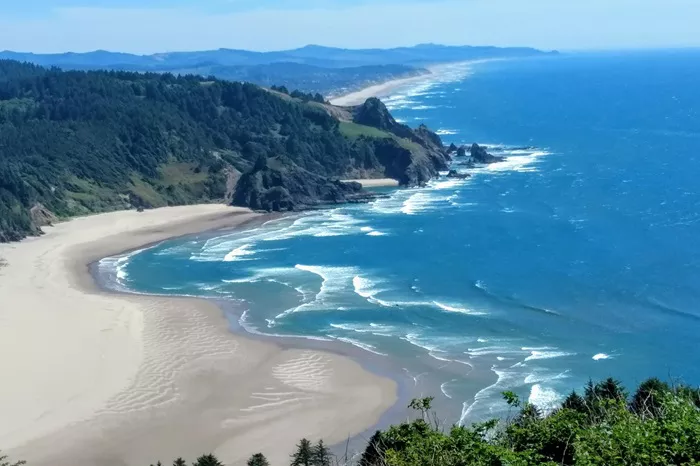Nestled along the stunning Oregon Coast, Cascade Head is a breathtaking hiking destination known for its panoramic views, diverse wildlife, and unique ecological significance. Whether you’re a seasoned hiker or a casual adventurer, this hike offers an unforgettable experience. In this guide, we’ll explore the trail lengths, difficulty levels, scenic highlights, accessibility, and essential tips for making the most of your Cascade Head hike.
Trail Length
Cascade Head features two primary hiking trails, each offering a different experience:
Nature Conservancy Trail: This trail is approximately 6.6 miles round trip and offers some of the best views along the Oregon Coast.
Lower Cascade Head Trail: This option is shorter, at 4.7 miles round trip, but still provides a rewarding hiking experience.
Both trails lead to spectacular viewpoints, where hikers can take in the beauty of the Pacific Ocean, the Salmon River Estuary, and rolling coastal headlands.
Trail Difficulty
The trails at Cascade Head are moderate in difficulty due to steady elevation gains and occasional steep sections:
Nature Conservancy Trail: Elevation gain of approximately 1,310 feet, making it a more strenuous option.
Lower Cascade Head Trail: Elevation gain of around 1,200 feet, with a slightly gentler ascent.
Expect well-maintained trails with some rugged terrain, tree roots, and switchbacks. While not overly technical, a moderate level of fitness is recommended.
Trail Descriptions
Nature Conservancy Trail
This trail starts at the upper trailhead and winds through lush coastal forests before emerging onto open meadows. Along the way, hikers will encounter:
Dense spruce and hemlock forests, providing shade and a peaceful hiking experience.
Expansive meadows, where wildflowers bloom in spring and summer.
Breathtaking ocean views, particularly near the summit.
The Oregon silverspot butterfly habitat, an endangered species protected in this area.
Lower Cascade Head Trail
This trail begins at Knight Park and follows a more gradual route through the forest before climbing toward the meadows. Key features include:
Salmon River Estuary views, offering a glimpse of a thriving coastal ecosystem.
Old-growth Sitka spruce trees, some towering over 100 feet tall.
Seasonal wildflowers and diverse bird species, making it a great option for wildlife lovers.
Accessibility
While Cascade Head is a must-visit, it’s essential to plan your trip accordingly:
Seasonal Closures: The upper trailheads are closed from January to mid-July to protect sensitive wildlife, including the Oregon silverspot butterfly.
Trail Conditions: The trails can be muddy after rain, so waterproof hiking shoes are recommended.
Skill Level: These trails are suitable for moderate hikers but may be challenging for beginners due to elevation gain.
Trail Maps and Directions
For trail maps, visit the official websites of the Nature Conservancy and Siuslaw National Forest. You can also find detailed maps on hiking apps like AllTrails and Gaia GPS.
Directions to Trailheads
Lower Trailhead: Located at Knight Park, near the intersection of Three Rocks Road and Hwy 101.
Upper Trailhead: Located off Cascade Head Road (seasonally closed).
Visitor Reviews and Ratings
Hikers consistently rate Cascade Head as one of the best hikes on the Oregon Coast:
Google Reviews: 4.8/5 (based on over 1,000 reviews)
AllTrails: 4.7/5, with hikers praising the stunning views and diverse terrain.
Yelp: 4.5/5, with mentions of the well-maintained trails and abundant wildlife.
Many reviewers highlight the hike’s unparalleled ocean views, the peaceful forest sections, and the rewarding summit experience.
Additional Activities
Cascade Head is not just about hiking. Visitors can also enjoy:
Birdwatching: Spot bald eagles, osprey, and migrating shorebirds.
Wildlife Viewing: Look out for elk, deer, and coastal foxes.
Photography: Capture stunning landscapes, particularly at sunrise or sunset.
Beach Walks: Visit nearby beaches such as Roads End for a relaxing post-hike stroll.
Tips for a Successful Hike
To make the most of your Cascade Head adventure, keep these tips in mind:
Wear sturdy hiking boots to handle the trail’s uneven terrain.
Dress in layers, as coastal weather can change rapidly.
Bring plenty of water and snacks, especially for the longer trail.
Start early in the morning to avoid crowds and experience the best lighting.
Respect wildlife and stay on designated trails to protect the sensitive ecosystem.
Check trail conditions before heading out, especially in wet weather.
Conclusion
The Cascade Head hike is a must-visit destination for outdoor enthusiasts looking to experience Oregon’s coastal beauty. Whether you choose the longer Nature Conservancy Trail or the shorter Lower Cascade Head Trail, you’ll be rewarded with stunning ocean views, lush forests, and an unforgettable adventure. Plan your trip wisely, follow the trail guidelines, and enjoy one of the most scenic hikes in the Pacific Northwest!

